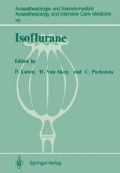Abstract
Succinylcholine (sch)-induced increase in serum myoglobin concentration is essentially influenced by the type of anaesthetic agent selected. Under halothane anaesthesia, for example, Inagaki and co-workers [7] observed an increase 34 to 54 times greater than under the influence of intravenous anaesthesia with Althesin or thiopental. The newer volatile substances have as yet not been studied concerning this aspect.
Access this chapter
Tax calculation will be finalised at checkout
Purchases are for personal use only
Preview
Unable to display preview. Download preview PDF.
References
Auerbach VH, Di George AM, Mayer BW, Hayden M, Carpenter GG, Krumperman LW, Truter TR (1973) Rhabdomyolysis and hyperpyrexia in children after administration of succinylcholine. In: Gordon RA, Britt BAm Kalow W (eds) International symposium on malignant hyperthermia. Thomas, Springfield
Bennike KA, Jarnum S (1964) Myoglobinuria with acute renal failure possibly induced by suxamathonium. Br J Anaesth 36: 730–736
Bernhardt D, Hoerder MH (1981) CK Isoenzyme bei anaesthesieinduzierter Myoglobinurie ( AIM ). Anesthesist 30: 131–133
Gessler U (1976) Das akute postoperative und posttraumatische Nierenversagen. Chirurg 47: 177–180
Gessler U, Loreth K, Schroder K, Steinhausen M (1966) Eperimentelle Untersuchungen über die glomeruläre Filtration anurischer Ratten nach Hämatinvergiftung. Klin Wochenschr 44: 628–633
Harrington F, Douglas J, Striker W (1983) Myoglobinemia and myoglobinuria after succinylcholine in children. Anesthesiolgoy 59: A439
Inagaki K, Koyama A, Sakata S, Tonogai R, Yamada Y (1980) Serum myoglobin levels following administration of succinylcholine during nitrous oxide-oxygen-halothane anesthesia. Jpn J Anesth 29: 1476–1482
Jensen K, Bennike K-AA, Hanel HK, Olesen H (1968) Myoglobinuria following anaesthesia including suxamethonium. Br J Anaesth 40: 329–334
Kaiser H, Sold G, Dittmann H, Griindler U, Rumpf KW, Schrader J, Spaar U, Köstering H, Kreuzer H (1981) Myoglobin im Serum: Referenzwerte und Klinik. Lab Med 5: 283–289
Kießling WR, Beckmann R (1981) Serum levels of myoglobin and creatine kinase in Duchenne muscular dystrophy. Klin Wochenschr 59: 347–348
Kießling WR, Ricker K, Pflughaupt KW, Mertens HG, Haubitz I (1981) Serum myoglobin in primary and secondary skeletal muscle disorders. J Neurol 224: 229–233
Lane RJM, Mataglia FL (1978) Drug-induced myopathies in man. Lancet II: 562–566
Lewandowski KB (1981) Rhabdomyolysis, myoglobinuria and hyperpyrexia caused by suxamethonium in a child with increased serum creatine kinase concentrations. Br J Anaesth 53:981– 984
McLaren CAB (1968) Myoglobinuria following the use of suxamethonium chloride. A case report. Br J Anaesth 40: 901–902
Plötz J (1984) Nebenwirkungen von Succinylcholin auf die Skelettmuskulatur in Halothannarkose bei Kindern. Prophylaxe mit Diallylnortoxiferin, “self-taming”und Dantrolen. Therapiewoche 34: 3168–3184
Schaer H, Steinmann B, Jerusalem S, Maier C (1977) Rhabdomyolysis induced by anaesthesia with intraoperative cardiac arrest. Br J Anaesth 49: 495–499
Editor information
Editors and Affiliations
Rights and permissions
Copyright information
© 1986 Springer-Verlag Berlin Heidelberg
About this paper
Cite this paper
Plötz, J. (1986). Influence of Isoflurane, Enflurane and Halothane on Serum Myoglobin Concentration After Succinylcholine Administration — A Comparison in Children. In: Lawin, P., Van Aken, H., Puchstein, C. (eds) Isoflurane. Anaesthesiology Intensive Care Medicine/Anaesthesiologie und Intensivmedizin, vol 182. Springer, Berlin, Heidelberg. https://doi.org/10.1007/978-3-642-71230-2_46
Download citation
DOI: https://doi.org/10.1007/978-3-642-71230-2_46
Publisher Name: Springer, Berlin, Heidelberg
Print ISBN: 978-3-540-16574-3
Online ISBN: 978-3-642-71230-2
eBook Packages: Springer Book Archive

